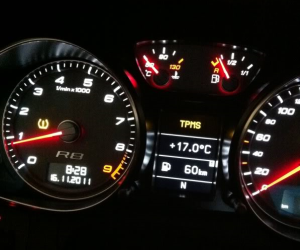Latest News From Bumper to Bumper Radio
 Newer model vehicles are equipped with a tire pressure monitoring system (TPMS) to warn drivers that at least one of their tires is underinflated. The dashboard light looks like an exclamation point inside of a horseshoe and, if illuminated, should be addressed immediately, says the non-profit Car Care Council.
Newer model vehicles are equipped with a tire pressure monitoring system (TPMS) to warn drivers that at least one of their tires is underinflated. The dashboard light looks like an exclamation point inside of a horseshoe and, if illuminated, should be addressed immediately, says the non-profit Car Care Council.
“When the TPMS light goes on, it should not be ignored. Driving on underinflated tires can lead to an accident or cause damage to your vehicle,” said Rich White, executive director, Car Care Council. “As part of a proactive auto care plan, tire pressure should be checked monthly, including the spare, as tires can lose pressure due to a number of factors, including seasonal temperature changes.”
All vehicles manufactured after September 2007 feature a tire pressure monitoring system. When the TPMS warning light comes on, it means pressure in at least one of the tires has fallen 25 percent under the recommended pressure. Low tire pressure can be due to a number of factors, including climate, road hazards and driving conditions. Once the tires are inflated to the correct pressure as outlined in the owner’s manual, the warning light should go off. However, some vehicles may require a professional service technician to reset the light.
 (WASHINGTON, March 7, 2016) The national average price jumped six cents on the week, the largest one week increase since the beginning of the year. Today’s average price is $1.81 per gallon, and the national average is likely to continue to move higher due to spring turnaround activity and reductions in supply in select regional markets. Drivers are paying six cents more per gallon to refuel their vehicles versus one month ago; however, significant yearly discounts remain and pump prices are down 65 cents on the year.
(WASHINGTON, March 7, 2016) The national average price jumped six cents on the week, the largest one week increase since the beginning of the year. Today’s average price is $1.81 per gallon, and the national average is likely to continue to move higher due to spring turnaround activity and reductions in supply in select regional markets. Drivers are paying six cents more per gallon to refuel their vehicles versus one month ago; however, significant yearly discounts remain and pump prices are down 65 cents on the year.
In advance of the busy summer driving season, refineries typically undergo scheduled maintenance during the first two quarters of the year. This year’s spring turnaround has been characterized by lower-than-expected prices, which has prompted a number of refineries to adjust their maintenance schedules and/or cut production in response to abundant supplies. Refineries are also reportedly beginning to reduce production in preparation for the seasonal switchover to summer-blend gasoline. Prices generally move during this time of year and the impact of this shift in schedule, combined with other seasonal factors, may cause prices to swing at the regional level at a faster rate than normal as supply and demand seek balance. The lower price of crude oil and abundant supplies should keep a ceiling on how high gas prices move in the coming months, and barring any unexpected disruptions in supply, drivers should continue to benefit from relative savings at the pump.

Consumer Information on Takata National Air Bag Recalls
The recall of defective air bag inflators made by Takata now involves 14 vehicle manufacturers and millions of U.S. vehicles. The defective inflators, which are supposed to produce gas that fills air bags to protect vehicle occupants in the event of a crash, can create excess pressure that causes the inflator to explode, sending metal fragments flying into the passenger compartment, which can cause serious injury or death. Since May 2015, when Takata acknowledged that some of its inflators were defective and a risk to safety, NHTSA has been working to organize and speed-up the recall repairs, which constitute the largest and most complex safety recall in U.S. history. The most recent expansion of the recalls, announced January 22, involves more than 5 million inflators, bringing the total to more than 28 million inflators under recall in the United States. NHTSA is coordinating and accelerating the recalls to ensure that every American vehicle has a safe air bag as quickly as possible, and has issued Takata the largest civil penalty in NHTSA history for failing to disclose the defects in its inflators and for providing NHTSA with selective, incomplete, or inaccurate data about its inflators. Consumers can consult this page for updates on the progress of the recalls, for a list of affected makes and models, and for the latest NHTSA actions to address Takata’s defective inflators and protect the American public.

LONDON, March 8, 2016 /PRNewswire/ -- ABI Research, the leader in transformative technology innovation market intelligence, forecasts shipments of new cars featuring autonomous parking technologies to grow at 35% CAGR between 2016 and 2026 and for revenues to likewise show growth at 29.5% CAGR.
ABI Research identifies three phases of autonomous parking, with each successive stage set to gradually displace the former and all three coexisting to some degree over the next decade. Ultimately, technology will reach a point in which the car parks itself entirely, with no driver assistance or presence within the car required. In Phase 1, the car will provide steering assistance with the driver still inside the vehicle and in control. Phase 2 shows autonomous parking with the driver outside the vehicle but still in control, and Phase 3 introduces autonomous valet parking in which the driver leaves the vehicle at the entrance of a car park. The car then parks itself and waits for the driver to summon it when it's time to leave.
 (WASHINGTON, March 14, 2016) Gas prices have jumped by 12 cents per gallon this week, which is the largest weekly increase since early March 2015. Prices increased by double digits due to a decline in gasoline supplies, relatively strong demand and continued refinery maintenance. The national average has moved higher for 18 of the past 20 days for a total of 23 cents per gallon, and today’s price of $1.94 per gallon is the highest average in two months. Relatively low oil costs continue to provide drivers with year-over-year savings at the pump, and consumers are saving 50 cents per gallon compared to this same date last year.
(WASHINGTON, March 14, 2016) Gas prices have jumped by 12 cents per gallon this week, which is the largest weekly increase since early March 2015. Prices increased by double digits due to a decline in gasoline supplies, relatively strong demand and continued refinery maintenance. The national average has moved higher for 18 of the past 20 days for a total of 23 cents per gallon, and today’s price of $1.94 per gallon is the highest average in two months. Relatively low oil costs continue to provide drivers with year-over-year savings at the pump, and consumers are saving 50 cents per gallon compared to this same date last year.
Prices typically move higher at this time of year as gasoline demand begins to increase and refineries conduct seasonal maintenance. This year’s refinery maintenance season is characterized by lower-than-expected prices for crude oil and ample supplies, which should help keep pump prices relatively low compared to recent years. Prices in some regions may move significantly higher in the near term due to fluctuations in local supply and demand associated with continued maintenance and preparations for summer-blend gasoline in advance of the June 1 deadline for retail facilities to sell the cleaner blend.





















